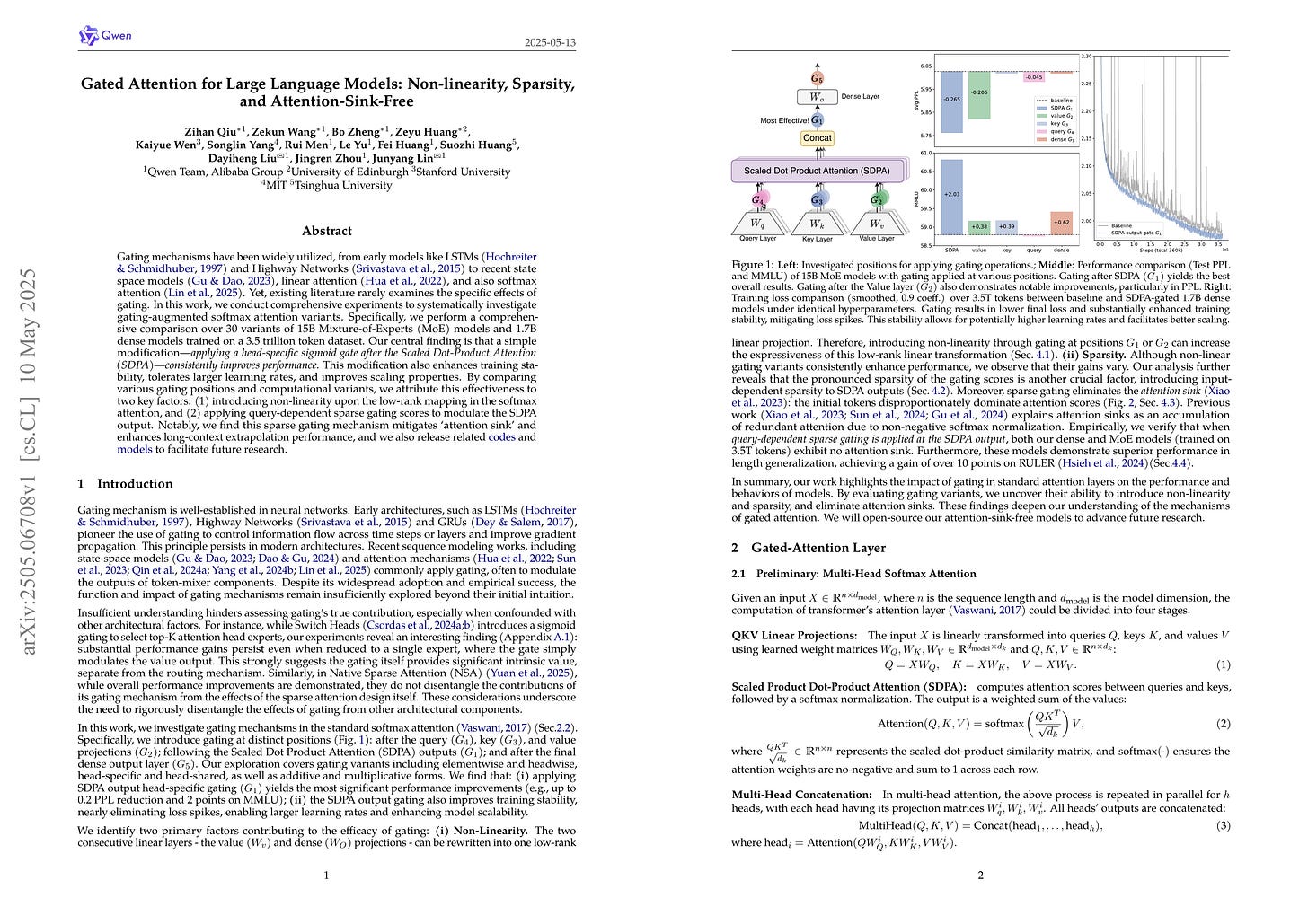2025년 5월 13일
Gated Attention for Large Language Models: Non-linearity, Sparsity, and Attention-Sink-Free
(Zihan Qiu, Zekun Wang, Bo Zheng, Zeyu Huang, Kaiyue Wen, Songlin Yang, Rui Men, Le Yu, Fei Huang, Suozhi Huang, Dayiheng Liu, Jingren Zhou, Junyang Lin)
Gating mechanisms have been widely utilized, from early models like LSTMs and Highway Networks to recent state space models, linear attention, and also softmax attention. Yet, existing literature rarely examines the specific effects of gating. In this work, we conduct comprehensive experiments to systematically investigate gating-augmented softmax attention variants. Specifically, we perform a comprehensive comparison over 30 variants of 15B Mixture-of-Experts (MoE) models and 1.7B dense models trained on a 3.5 trillion token dataset. Our central finding is that a simple modification-applying a head-specific sigmoid gate after the Scaled Dot-Product Attention (SDPA)-consistently improves performance. This modification also enhances training stability, tolerates larger learning rates, and improves scaling properties. By comparing various gating positions and computational variants, we attribute this effectiveness to two key factors: (1) introducing non-linearity upon the low-rank mapping in the softmax attention, and (2) applying query-dependent sparse gating scores to modulate the SDPA output. Notably, we find this sparse gating mechanism mitigates 'attention sink' and enhances long-context extrapolation performance, and we also release related codes and models to facilitate future research.
Attention에 게이트 추가. Stick-breaking Attention이나 Softpick이 생각나는군요 (https://arxiv.org/abs/2410.17980, https://arxiv.org/abs/2504.20966).
Adding a gate to attention. It reminds me of stick-breaking attention or softpick (https://arxiv.org/abs/2410.17980, https://arxiv.org/abs/2504.20966).
#transformer
Seed1.5-VL Technical Report
(ByteDance Seed)
We present Seed1.5-VL, a vision-language foundation model designed to advance general-purpose multimodal understanding and reasoning. Seed1.5-VL is composed with a 532M-parameter vision encoder and a Mixture-of-Experts (MoE) LLM of 20B active parameters. Despite its relatively compact architecture, it delivers strong performance across a wide spectrum of public VLM benchmarks and internal evaluation suites, achieving the state-of-the-art performance on 38 out of 60 public benchmarks. Moreover, in agent-centric tasks such as GUI control and gameplay, Seed1.5-VL outperforms leading multimodal systems, including OpenAI CUA and Claude 3.7. Beyond visual and video understanding, it also demonstrates strong reasoning abilities, making it particularly effective for multimodal reasoning challenges such as visual puzzles. We believe these capabilities will empower broader applications across diverse tasks. In this report, we mainly provide a comprehensive review of our experiences in building Seed1.5-VL across model design, data construction, and training at various stages, hoping that this report can inspire further research. Seed1.5-VL is now accessible at
https://www.volcengine.com/
(Volcano Engine Model ID: doubao-1-5-thinking-vision-pro-250428)
바이트댄스의 Vision Language 모델. 학습 도메인에 대한 Scaling Law도 재미있네요.
ByteDance's vision-language model. The scaling law for the training domain is also interesting.
#multimodal #scaling-law
AttentionInfluence: Adopting Attention Head Influence for Weak-to-Strong Pretraining Data Selection
(Kai Hua, Steven Wu, Ge Zhang, Ke Shen)
Recently, there has been growing interest in collecting reasoning-intensive pretraining data to improve LLMs' complex reasoning ability. Prior approaches typically rely on supervised classifiers to identify such data, which requires labeling by humans or LLMs, often introducing domain-specific biases. Due to the attention heads being crucial to in-context reasoning, we propose AttentionInfluence, a simple yet effective, training-free method without supervision signal. Our approach enables a small pretrained language model to act as a strong data selector through a simple attention head masking operation. Specifically, we identify retrieval heads and compute the loss difference when masking these heads. We apply AttentionInfluence to a 1.3B-parameter dense model to conduct data selection on the SmolLM corpus of 241B tokens, and mix the SmolLM corpus with the selected subset comprising 73B tokens to pretrain a 7B-parameter dense model using 1T training tokens and WSD learning rate scheduling. Our experimental results demonstrate substantial improvements, ranging from 1.4pp to 3.5pp, across several knowledge-intensive and reasoning-heavy benchmarks (i.e., MMLU, MMLU-Pro, AGIEval-en, GSM8K, and HumanEval). This demonstrates an effective weak-to-strong scaling property, with small models improving the final performance of larger models-offering a promising and scalable path for reasoning-centric data selection.
Retrieval Head 같이 추론 능력에 중요한 헤드를 마스킹했을 때와 아닐 때의 Loss 차이를 사용해서 추론 능력에 도움이 되는 데이터를 찾아낸다는 아이디어.
This paper presents an idea to identify data that enhances reasoning abilities by comparing the difference in loss when masking or not attention heads crucial for reasoning, such as retrieval heads.
#reasoning #mechanistic-interpretation #corpus
Continuous Visual Autoregressive Generation via Score Maximization
(Chenze Shao, Fandong Meng, Jie Zhou)
Conventional wisdom suggests that autoregressive models are used to process discrete data. When applied to continuous modalities such as visual data, Visual AutoRegressive modeling (VAR) typically resorts to quantization-based approaches to cast the data into a discrete space, which can introduce significant information loss. To tackle this issue, we introduce a Continuous VAR framework that enables direct visual autoregressive generation without vector quantization. The underlying theoretical foundation is strictly proper scoring rules, which provide powerful statistical tools capable of evaluating how well a generative model approximates the true distribution. Within this framework, all we need is to select a strictly proper score and set it as the training objective to optimize. We primarily explore a class of training objectives based on the energy score, which is likelihood-free and thus overcomes the difficulty of making probabilistic predictions in the continuous space. Previous efforts on continuous autoregressive generation, such as GIVT and diffusion loss, can also be derived from our framework using other strictly proper scores. Source code: https://github.com/shaochenze/EAR.
Quantization 대신 Energy Score를 사용해 Continuous한 입력에 대해 Visual Autoregression을 학습.
Visual autoregression trained on continuous inputs using energy score instead of quantization.
#autoregressive-model #image-generation
Discrete Visual Tokens of Autoregression, by Diffusion, and for Reasoning
(Bohan Wang, Zhongqi Yue, Fengda Zhang, Shuo Chen, Li'an Bi, Junzhe Zhang, Xue Song, Kennard Yanting Chan, Jiachun Pan, Weijia Wu, Mingze Zhou, Wang Lin, Kaihang Pan, Saining Zhang, Liyu Jia, Wentao Hu, Wei Zhao, Hanwang Zhang)
We completely discard the conventional spatial prior in image representation and introduce a novel discrete visual tokenizer: Self-consistency Tokenizer (Selftok). At its design core, we compose an autoregressive (AR) prior -- mirroring the causal structure of language -- into visual tokens by using the reverse diffusion process of image generation. The AR property makes Selftok fundamentally distinct from traditional spatial tokens in the following two key ways: - Selftok offers an elegant and minimalist approach to unify diffusion and AR for vision-language models (VLMs): By representing images with Selftok tokens, we can train a VLM using a purely discrete autoregressive architecture -- like that in LLMs -- without requiring additional modules or training objectives. - We theoretically show that the AR prior satisfies the Bellman equation, whereas the spatial prior does not. Therefore, Selftok supports reinforcement learning (RL) for visual generation with effectiveness comparable to that achieved in LLMs. Besides the AR property, Selftok is also a SoTA tokenizer that achieves a favorable trade-off between high-quality reconstruction and compression rate. We use Selftok to build a pure AR VLM for both visual comprehension and generation tasks. Impressively, without using any text-image training pairs, a simple policy gradient RL working in the visual tokens can significantly boost the visual generation benchmark, surpassing all the existing models by a large margin. Therefore, we believe that Selftok effectively addresses the long-standing challenge that visual tokens cannot support effective RL. When combined with the well-established strengths of RL in LLMs, this brings us one step closer to realizing a truly multimodal LLM. Project Page: https://selftok-team.github.io/report/.
Diffusion Objective에 이미지 토큰을 결합해 Autoregressive한 구조를 갖는 Discrete Token을 생성하는 토크나이저를 학습. 논문이 굉장히 야심찬데 흥미롭네요.
A tokenizer that generates discrete tokens with an autoregressive structure by combining image tokens with diffusion objectives. The paper is quite ambitious and intriguing.
#vq #diffusion #autoregressive-model
Learning Dynamics in Continual Pre-Training for Large Language Models
(Xingjin Wang, Howe Tissue, Lu Wang, Linjing Li, Daniel Dajun Zeng)
Continual Pre-Training (CPT) has become a popular and effective method to apply strong foundation models to specific downstream tasks. In this work, we explore the learning dynamics throughout the CPT process for large language models. We specifically focus on how general and downstream domain performance evolves at each training step, with domain performance measured via validation losses. We have observed that the CPT loss curve fundamentally characterizes the transition from one curve to another hidden curve, and could be described by decoupling the effects of distribution shift and learning rate annealing. We derive a CPT scaling law that combines the two factors, enabling the prediction of loss at any (continual) training steps and across learning rate schedules (LRS) in CPT. Our formulation presents a comprehensive understanding of several critical factors in CPT, including loss potential, peak learning rate, training steps, replay ratio, etc. Moreover, our approach can be adapted to customize training hyper-parameters to different CPT goals such as balancing general and domain-specific performance. Extensive experiments demonstrate that our scaling law holds across various CPT datasets and training hyper-parameters.
Continual Pretraining에 대한 Scaling Law. LR Annealing에 의한 항과 Distribution Shift에 의한 항으로 구성되는군요.
A scaling law for continual pretraining. It consists of terms on LR annealing and distribution shift.
#continual-learning #scaling-law










